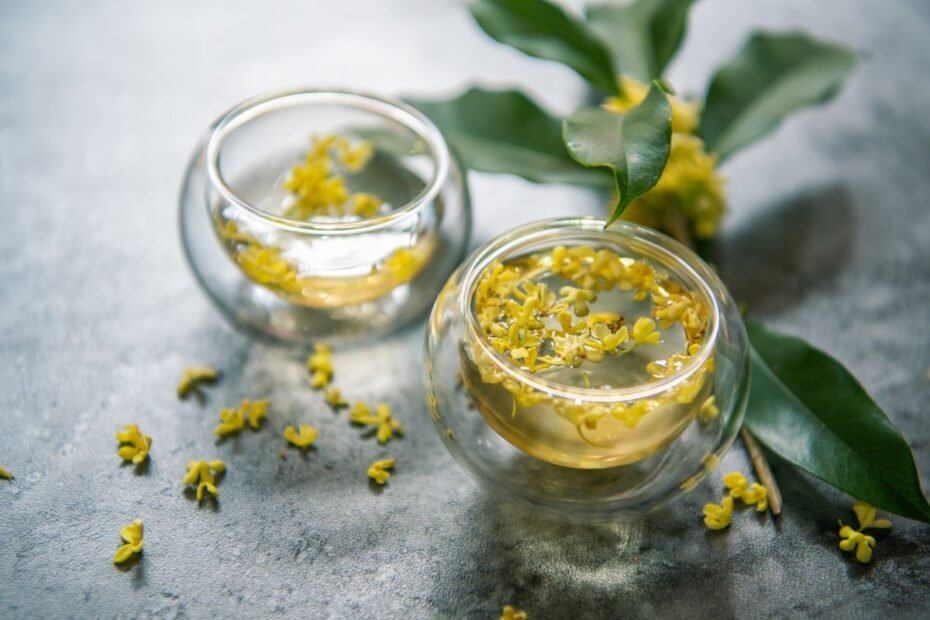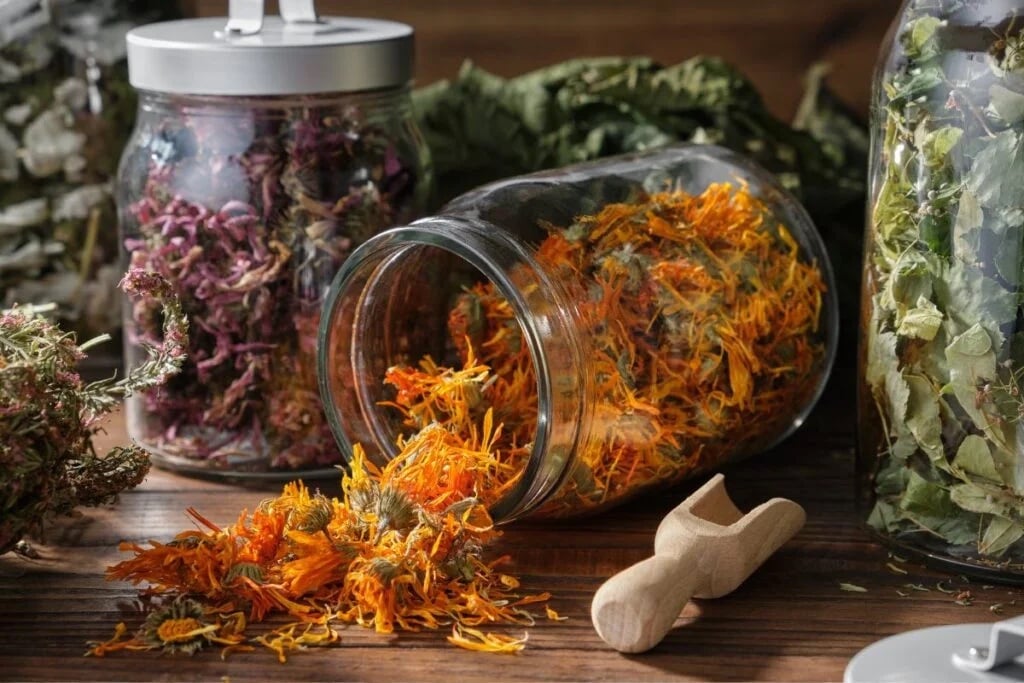Osmanthus tea, made from Osmanthus fragrans, is one of the traditional oriental teas. Finding natural osmanthus blossom tea in many countries’ supermarkets is challenging. In addition, the most common product you can find will not be these herbs but one of the common teas (green, oolong, or black) mixed with osmanthus blossoms or their aroma. Of course, the mentioned ones are also pleasant treats, like black tea with bergamot or green tea with jasmine. But in this article, we will look more closely at the pure one drink and discuss osmanthus tea benefits as well. We want to offer you an insight into this tea and, if possible, wish you an aristocratic enjoyment of this drink.
What is Osmanthus?
Osmanthus is an ornamental, flowering, and highly aromatic plant belonging to the Oleaceae family. About 30 species are known worldwide. The warm-weather plant is native to Southeast Asia and is mainly found in the southern United States, the Pacific Islands, and south-eastern China. It also has other names: sweet osmanthus, tea olive, sweet olive, and fragrant olive.
The osmanthus is an evergreen tree or shrub. Depending on the climate and growing conditions, it can grow up to 2–3 or even 6 m tall. The plant has dark green, lance-shaped, and leathery leaves. It produces white or yellowish, small, clustered, intensively fragrant flowers. The last feature gives it its name, osmanthus, meaning ‘fragrant flowers.’ The flowers are considered to be some of the most aromatic. The osmanthus produces edible, olive-like, blue-black stone fruits.
In many areas, like Europe, the osmanthus plant does not grow outdoors. They cannot withstand temperatures below -12 °C. However, gardeners grow it indoors, in a conservatory as an ornamental plant.

What is Osmanthus Tea?
Osmanthus tea has a long tradition in China, dating back more than 2500 years. Here, the tea satisfies taste buds, and it also has deep traditions in Chinese medicine.
Osmanthus tea is a product, that drinkers make it from dried blossoms. It has a distinctive floral aroma and an apricot-creamy flavor with hints of flowers. People pick the flowers in late summer and dry them to make tea.
However, another version of osmanthus tea is more widely used outside China. This is a tea with the flowers or aroma of osmanthus. The most common tea blended is oolong tea. However, green and black teas are also used to make this tea. These versions of sweet olive tea dominate the tea market around the world.
Osmanthus Tea Benefits
Osmanthus blossom tea is rich in vitamins and minerals beneficial to the human body, such as vitamins A, B, and C, calcium, potassium, and iron. They are also rich in flavonoids and antioxidants, such as polyphenols and niacinamide. Everybody knows, that these substances positively affect overall human health. Osmanthus tea benefits include:
- It helps to relax and calm the body and mind. You can choose it when suffering from insomnia or anxiety.
- Strengthens the immune system. This is due to the antioxidants.
- Helps digestion. This tea has been used for centuries to aid digestion and relieve constipation and nausea.
- Supports skin health. The tea’s antioxidants help to protect the skin from free radical damage, keeping the skin healthy and youthful.
- Supports brain function. Studies have shown that eugenol and geraniol in the osmanthus may prevent Alzheimer’s disease. Even more interestingly, the aroma of the flowers can affect the brain. It suppresses appetite and can therefore help you lose weight.
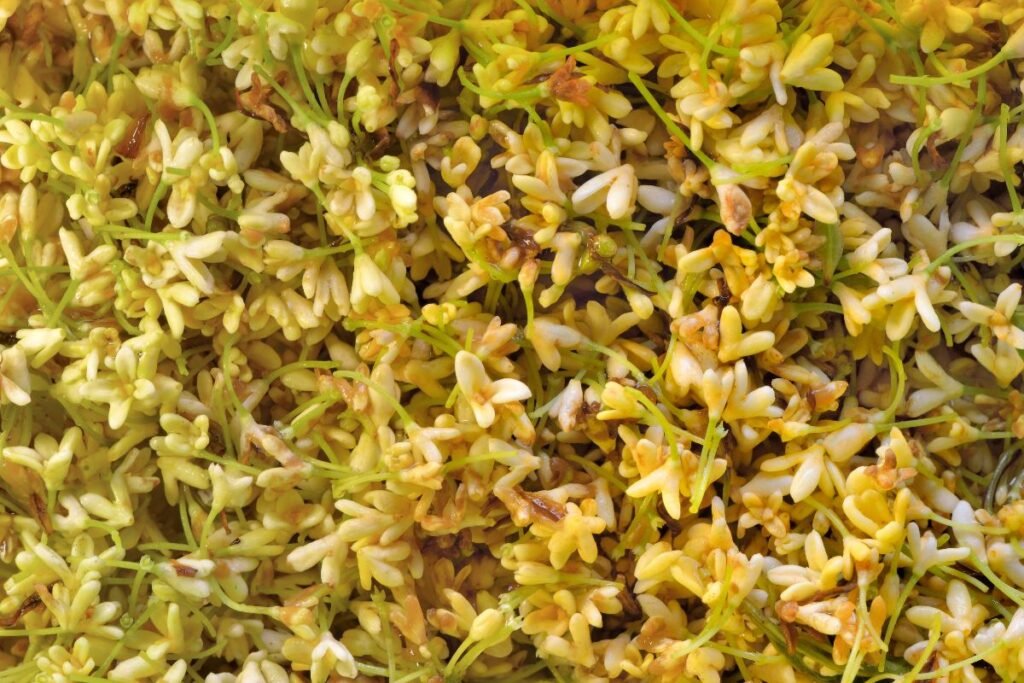
Osmanthus Blossoms Tea
You need use dried, high-quality osmanthus blossoms to make a proper osmanthus tea. If you have these herbs at home, store them correctly, preserving the quality of the product for a long time, i.e., in an airtight container in a dry, cool, and dark vase.
You can put some tea herbs in a cup or tea infuser. Recommendations suggest using one teaspoon of osmanthus flowers per cup of tea. Once you brew the tea, it is advisable to steep it for at least 3 minutes, depending on the intensity of the tea flavor you want.
When steeped, the tea became a pale yellow with a strong, pleasant aroma reminiscent of apricots and peaches. The taste is fruity and sweet, with a subtle floral aftertaste.
You can make decoction as a more concentrated osmanthus blossom tea. Studies have shown that 2 grams of osmanthus blossom in 1 liter of water boiled for 20 minutes produces a concentrated drink with immune-boosting properties. The decoction of osmanthus blossom is bitter, and the recommendation says to sweeten it with honey.
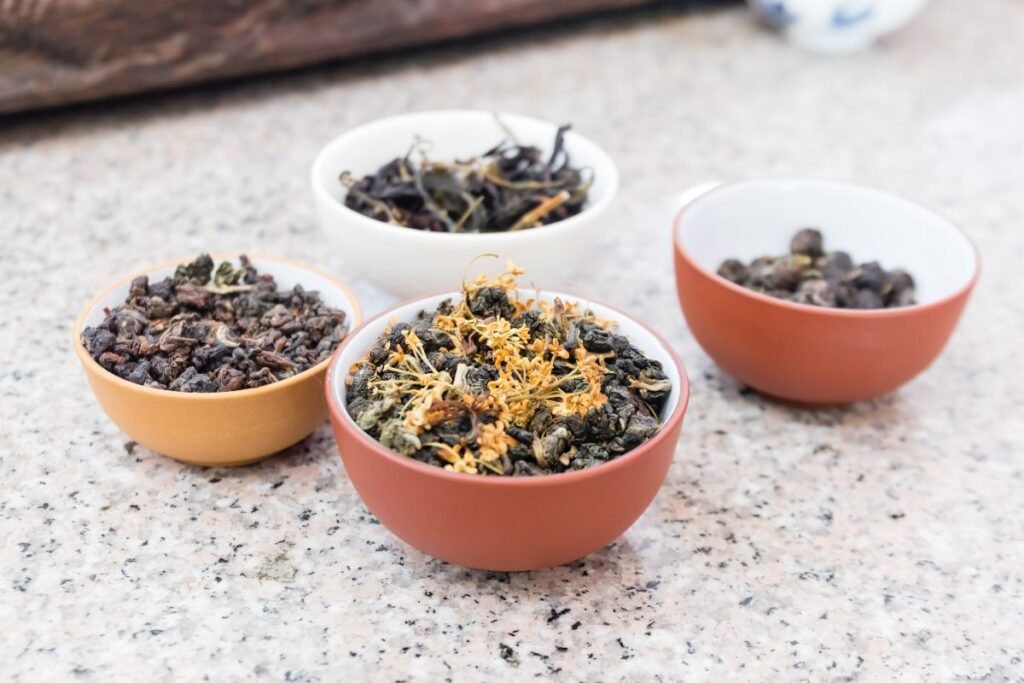
Variations of Osmanthus Tea
Osmanthus blossoms are most suitable for blending with other flowers or herbal teas. They are also a way of flavoring traditional teas such as ulongo, green, and black.
The flowers of the osmanthus can be combined with:
- Jasmine tea. These two types of aromatic flowers produce a delicately flavored and aromatic beverage, particularly suitable for lovers of floral, mild, and sweet teas.
- Lavender tea. This tea has a delicate floral flavor. Mixed with osmanthus blossom, it makes a relaxing, soothing tea.
- Rose tea. This tea, together with the flowers of the Osmanthus tree, is a source of positivity with its aroma and pleasant floral flavor, lifting the mood and restoring energy.
- Mint tea. Mint leaves mixed with osmanthus blossom make a refreshing, cooling, tonic tea.
Here we suggest only a few ideas for tea combinations. But this list is not complete. Combine the flowers as you wish to create a cup of tea that suits you best.
Tea with Osmanthus Flowers or Its Aroma
As mentioned earlier, osmanthus tea is oolong, green, or black tea with or without the aroma of osmanthus flower.
Oolong tea is the most prevalent base for osmanthus tea. This type of tea is mixed with the osmanthus flowers in the production process. The tea is also flavored with these flowers at some stage. Sometimes, the base could be green or black tea.
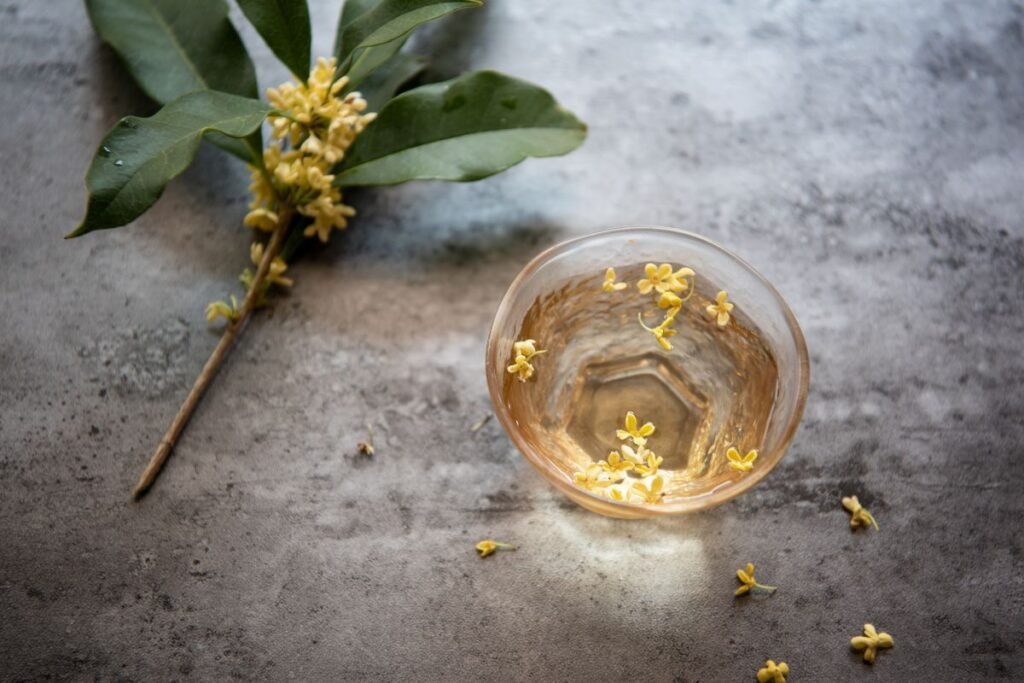
Osmanthus tea
This tea is valuable for its taste and pleasant aroma. It also contains health-giving substances for the human body. The antioxidant effect is one of many benefits that combine harmless properties. It boosts immunity and protects against free-radical damage.
However, while osmanthus tea does not contain caffeine, oolong, green, or black do. Therefore, if you are controlling your caffeine intake, carefully choose the right product for you.
Osmanthus, for other uses
Due to its aromatic and flavoring properties, the osmanthus plant is a common ingredient in culinary, confectionery, cosmetic, and perfumery products.
Its sweet, fruity, and floral flavor enriches the taste of pastries, liqueurs, and cocktails. People add osmanthus to these products to extract the flavor notes mentioned.
In the same way, the pleasant and intense aroma of the sweet olive flowers makes them one of the main ingredients in the perfumery industry.
Not only for their aroma but also for their antioxidant properties, blossoms are used in cosmetic products and beauty treatments. For example, people use tea as a natural skin tonic to protect the skin from oxidative damage and help preserve its youthfulness.
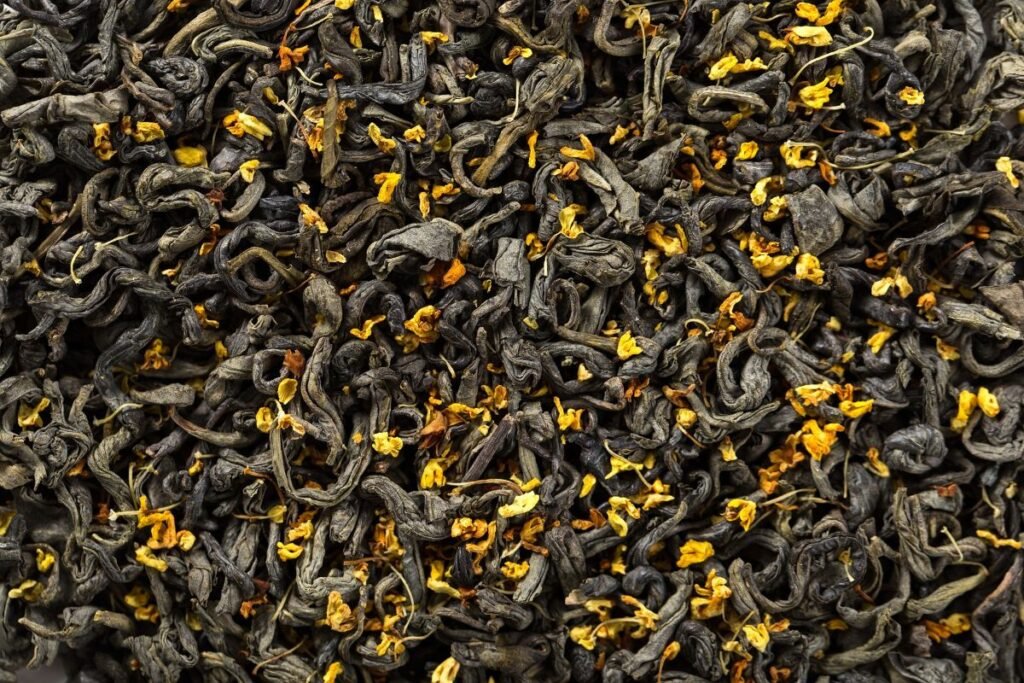
Can Osmanthus Tea Have Side Effects?
Osmanthus tea does not frequently cause any side effects. The most probable side effect may be an allergic reaction. Allergies indicate skin rashes, itching, or even difficulty breathing.
Certain groups of people should also moderate or refrain from using the tea. Be careful if:
- You have a gastrointestinal condition, are being treated for it, and are taking medication. In this case, this tea may exacerbate digestive problems and cause nausea or diarrhea.
- You have diabetes. In this case, the tea can dangerously lower your blood sugar levels.
- Pregnant and breastfeeding women should be cautious when drinking osmanthus tea. For children, this tea is recommended only in small quantities.
If you consume non-pure osmanthus tea (based on oolong, green, or black herbs) that contains caffeine, limit, moderate, or avoid the tea.
Sources:
- https://simplelooseleaf.com/blog/herbal-tea/osmanthus-tea/#_ftn2
- https://www.vle.lt/straipsnis/kvepene/
- https://herbalteahealthbenefits.com/osmanthus-tea/
Researches:
- https://www.sciencedirect.com/science/article/pii/S0254629915002276
- https://www.researchgate.net/publication/286648528_Effect_of_an_osmanthus_fragrans_flower
- https://www.ncbi.nlm.nih.gov/pmc/articles/PMC3872418/
- https://pubmed.ncbi.nlm.nih.gov/23519146/
- https://www.researchgate.net/publication/286648528_Effect_of_an_osmanthus_fragrans_flower
Associative photos from © Canva.
